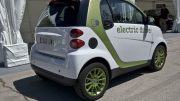 The European Commission is expected to propose a new method for measuring trucks’ CO2 emissions this summer, marking the EU’s first step towards regulating carbon dioxide from heavy duty vehicles. The computer simulation tool, called VECTO, has been several years in the making, and was developed jointly with truck makers. VECTO is one crucial step in the Commission’s efforts to curb emissions from trucks, buses and coaches. Up until now, CO2 emissions were neither measured nor reported, something that should soon become mandatory. Industry groups and campaigners alike are now wondering if the EU executive will introduce binding limits on truck pollution. On its website, the Commission says the most apparent option is to set mandatory limits on average CO2 emissions from newly-registered HDVs, as is already done for cars and vans.
The European Commission is expected to propose a new method for measuring trucks’ CO2 emissions this summer, marking the EU’s first step towards regulating carbon dioxide from heavy duty vehicles. The computer simulation tool, called VECTO, has been several years in the making, and was developed jointly with truck makers. VECTO is one crucial step in the Commission’s efforts to curb emissions from trucks, buses and coaches. Up until now, CO2 emissions were neither measured nor reported, something that should soon become mandatory. Industry groups and campaigners alike are now wondering if the EU executive will introduce binding limits on truck pollution. On its website, the Commission says the most apparent option is to set mandatory limits on average CO2 emissions from newly-registered HDVs, as is already done for cars and vans.
Disproportionate share
Trucks only make up a small part of vehicles on the roads in Europe: less than 5% of total traffic. But they’ve alarmed regulators because of the disproportionate share of CO2 emissions they create. Between 1990 and 2010, CO2 emissions from trucks rose by 36% in Europe, according to Commission figures. Road freight continues to increase in Europe, so more trucks are driving on roads now than ever before. That puts the Commission in a tough position. Estimations from the EU executives show that emissions from trucks will remain at around the same level until 2050. This would run contrary to a Commission pledge to drastically bring down CO2 emissions from the transport sector. In its 2011 Transport White Paper, the EU executive outlined a 60% cut from emissions levels in 1990. That was backed up by the Commission’s plan for a low-carbon economy in 2050, which called for more fuel efficient diesel and petrol engines and an increase in electric and hybrid cars on the European market.
Technology
Manufacturers and industry groups have embraced several technological developments that could cut CO2 emissions. These include cleaner fuels, electrified vehicles, and use of ‘connected’ or digital communication with infrastructure and other vehicles to make driving more efficient. But campaigners argue a binding limit to truck emissions would be the only way to significantly speed up adoption of cleaner technologies and make a real dent on overall CO2 emissions.
Regulation of truck emissions – why the wait?
Several EU member states are actively pushing for binding limits on CO2 emissions form trucks to be set at European level. In September 2015, the UK, Slovenia, the Netherlands and Belgium called on the European Commission to introduce binding limits on truck’s CO2, which account for 30% of road transport emissions. The Umweltbundesamt, the German environmental protection agency, also said there is a need for “a more intensive discussion about CO2 limit values” for trucks. The agency emphasised, “we also require ambitious regulation”. The European Parliament has joined the calls and put pressure on the Commission to regulate. In a report published last September, the Parliament said that “if appropriate” the executive should set out obligatory limits to CO2 levels from newly registered trucks. But so far, the Commission has refused to come out with a proposal to put a legally binding lid on CO2 emissions from trucks. Instead, it chose to focus on developing a methodology, called VECTO, for manufacturers to monitor and report on emissions as a first step. Looking forward, “the most apparent option is to set mandatory limits on average CO2 emissions from newly-registered HDVs, as is already done for cars and vans,” the Commission said. This is making manufacturers cringe. Erik Jonnaert, secretary general of the European Automobile Manufacturers’ Association (ACEA), said the European truck industry is “too complex” to be regulated by across-the-board CO2 limits, and that there are too many different kinds of trucks on the market for legally binding limits to make sense. ACEA has instead advocated for other methods to cut CO2 emissions, including better truck models, internet connectivity in vehicles and road engineering that can facilitate driving in a way that creates less pollution. The car industry and environmental campaigners are now looking ahead to a proposal from the European Commission expected this June on the decarbonisation of transport. Some have speculated that the proposal might address trucks and CO2 emissions specifically, and even include a binding limit.
Fuel efficiency
Up until now, CO2 reductions were mainly driven by demand for trucks that consume less. “Put simply, the best-in-class on fuel consumption will sell more, and provide better business for us as manufacturers,” said Niklas Gustafsson, Chief Sustainability Officer at the Volvo Group, in a recent interview with EurActiv. But although fuel efficiency has improved, CO2 emissions have continued to rise since the 1990s, mainly due to increasing road freight traffic. “This is clearly incompatible with the goal of reducing greenhouse gas emissions from transport by around 60% below 1990 levels by 2050,” the Commission said, referring to its 2011 Transport White Paper. As often, industry and environmental campaigners cite widely varying statistics on how fuel efficient European trucks really are. ACEA argues that trucks in Europe today are one third more fuel efficient than they were in the 1980s. The industry association predicts that trend will grow: new heavy duty vehicles will be around 15% more fuel efficient by 2020 because of technological developments. But NGOs disagree with those figures. A study from The International Council on Clean Transportation argues that the level of CO2 emissions from tractor trailers has remained constant since the early 2000s. The organisation draws comparison to an opposite trend in the United States, where trucks have improved their fuel efficiency as the result of emissions regulation.
Larger trucks: More efficient than small ones?
The ICCT study also claimed that trucks sold in the EU are becoming heavier and larger, contributing to more fuel consumption. But the claim that smaller trucks are more fuel-efficient is subject to debate. While smaller vehicles might emit less individually, industry representatives say longer modular trucks actually pollute less on aggregate because fewer of them are needed on the road. They point to Nordic countries, which already allow combining loading modules to have longer trucks, improving logistics efficiency along the way. EU legislators were unable to resolve the controversy when they adopted new legislation last year on lorry design. While the new law allows larger and more aerodynamic vehicles to be put on the road, trucks that cross EU borders won’t be allowed to exceed 18.75 metres in length and 40 tonnes in weight. The larger ones, which Green legislators refer to as “monster trucks”, will only be used for trials within national borders, like in Scandinavia. Ismail Ertug, a German MEP from the Socialists & Democrats (S&D) group said the ban on large ‘megatrucks’ traveling between EU countries “will not only reduce CO2 emissions through improved aerodynamics, they will allow for a wider field of vision through the installation of bigger windshields, thus improving safety for drivers. “ This view was not shared by Nordics, however: “With the bigger trucks, we can also achieve considerable reductions in logistical costs,” said Merja Kyllˆnen, a Finnish MEP from the leftist GUE/NGL group in the European Parliament.
VECTO
Part of the “magatruck” controversy is down to differences in measurements. Currently, there is no official EU-wide method to measures CO2 emissions from trucks. As a first step towards regulation, the European Commission has helped truckmakers develop a methodology to measure emissions from heavy duty vehicles. The new measurement system, called Vehicle Energy Consumption Calculation Tool (VECTO), is a computer simulation programme which is expected to become mandatory as of this summer after the Commission issues new legislation. The proposal has dragged on for several years. VECTO is supposed to give an accurate reading of fuel consumption in actual driving conditions so that buyers get the information before making a purchase. VECTO will measure CO2 emissions and fuel consumption based on a range of information such as overall truck mass, tire dimensions and engine type. After years of testing, the Commission claims VECTO is now accurate within a 3% margin of error. Truck manufacturers at ACEA have praised VECTO, saying the new tool will allow consumers to choose the most fuel efficient truck, putting pressure on the industry to produce vehicles that are more fuel efficient. However, they are also worried that the methodology will not take account of all potential parameters influencing fuel consumption, such as the use of biofuels. “To us it is very important to look at the trucking industry in an integrated way, taking into account what can be done from a technology point of view on the engine, on low rolling-resistance tyres, on aerodynamics, etc.,” said Niklas Gustafsson Chief Sustainability Officer at the Volvo Group. “But we should also look at efficient fuels, infrastructure, logistics and other parameters that influence fuel consumption. Because you can have a very efficient drivetrain and still not be very efficient if you have a poor logistic system.” Green NGO Transport & Environment agrees that VECTO will mark an improvement on measuring trucks’ fuel efficiency and could boost competition between manufacturers who will be incentivised to build cleaner vehicles. But the NGO argues that VECTO should be more transparent than it was in trial phase. Data used to calculate emissions and efficiency should be made accessible to third parties so that they can test trucks during use, T&E said. The Commission’s current version of VECTO makes much of that data confidential, meaning that only OEMs that manufacture truck parts can use the test.
Electrification
In the long run, technological developments ó including electrification ó are expected to play a big role in reducing truck emissions. The European Commission has touted electric vehicles as a step towards cutting CO2 from vehicles across the board because they do not emit tailpipe exhaust. It has funded research projects to develop new technology and try to tackle some of the main issues standing in the way of electric vehicles going mainstream, including cost, battery reliability and charging. But a 2011 study funded by the Commission said electric trucks are still a ‘niche’ market, mainly because the technology is not mature enough and the costs too high. So far, the technology has been used mainly for city buses travelling on short distances without heavy loads. Hybrid-electric buses already on the market can save a lot of fuel, in particular in stop-and-go urban traffic conditions, says Volvo’s Gustafsson. In his view hybrid diesel engines are a stepping stone towards heavier trucks that eventually become fully electrified. However, for long-distance trucking, liquid fuels will remain dominant for the foreseeable future, he said. “The amount of batteries that would need to be equipped on long-distance trucks would be so huge, it wouldnít make sense. So you need to bring energy in some other form. And if you donít want to go for fossil-based diesel, then you need alternative or renewable fuels in liquid form so you can bring the amount of energy needed for long-distance trucking.” Volvo is not alone looking at electrification. BMW started running fully electric trucks on short distances in Germany last year (2015). Some technological developments would help trucks use more electric power by using power supplies based in road infrastructure. In an experiment billed as the ‘eHighway’, Siemens is currently testing a new electric overhead metal track to power trucks on a 2.1 km-long stretch of highway outside Berlin. Last summer, Siemens outfitted a short stretch of a public highway in Sweden with the overhead electric rails to connect to trucks. Siemens says using the electrified overhead track to connect to trucks as they drive will be energy efficient. The company says the technology will be available soon for commercial use.
Intelligent transport systems
The European Commission is also pushing ‘intelligent transport systems’ (ITS), or the technological communication between vehicles and road infrastructure. ITS technology facilitates information sharing to help drivers find parking spots, travel routes and pay tolls. The Commission and some of the groups pushing ITS, like public-private organisation ERTICO, argue that increasing ITS technology use on the road will decrease traffic congestionóand cut CO2 emissions as a result. The Commission also wants ITS technology to help cargo carriers combine loads more efficiently, meaning less trucks could be on the road. Overall, the EU executive estimates that using ITS technologies can cut CO2 emissions by 10-20%. There are obstacles to expanding ITS, however: the International Road Union told EurActiv in a recent interview that commercial truck operators are reluctant to share information about their travel routes with authorities. A study conducted by ERTICO last October found the average fuel savings from ITS systems was 6.4% for passenger cars, a figure which was even slightly higher for trucks and buses. Digital technologies have also been developed to group vehicles into “platoons” as a way of reducing emissions and increase road capacity. In April 2016, the Dutch Council Presidency is organising an experiment to test trucks that drive semi-autonomously, or without complete driver control. A fleet of trucks will drive from other European countries to Rotterdam on 6 April in a ‘truck platooning’ test that can cut CO2 emissions by up to 20%, according to the Dutch presidency. Trucks drive close to each other to reduce the air drag between them, which can save fuel.
Tolls
Regulators have also considered green tolling systems as a way of cutting CO2 emissions from road traffic in general. EU Transport Commissioner Violeta Bulc has said she wants to introduce a unified, EU-wide road toll system that would override the patchwork of different national road tolls. An EU directive dating back to 1999 allows member states to introduce tolls for trucks that are based either on distance or time travelled. Bulc is in favour of tolls that are based on the distance vehicles drive, not on the amount of time they use roads. Last November, 14 MEPs wrote a letter to Bulc asking her to reform the directive and scrap road tolls based on distance. Instead, the MEPs asked for new legislation that would require road tolls be determined by trucks’ CO2 emissions levels and fuel efficiency. Tolls based on how long trucks use roads do not promote efficient vehicles or driving, the MEPs argued. T&E suggests charging tolls based on trucks’ CO2 emissions recorded by the VECTO tests. Trucks that are not certified by a VECTO test could be charged the highest possible road toll, the NGO argued. A study carried out by consultancy CE Delft said road tolls based on trucks’ CO2 emissions could be a good potential policy instrument. It argued that other measures to charge road users, such as raising fuel taxes, would have less public support. ACEA said in a recent position paper that European vehicle manufacturers see no need for new road tolls to limit air pollution since the current EU road toll system has reduced emissions and emissions are already curbed by fuel taxes. Tolls that charge trucks based on greenhouse gas emissions would discourage road transport in favour of other modes of transport ó such as trains and barges ó which the Commission wants to encourage.
Positions
Germany’s Umweltbundesamt is among one of the national authorities that have called for binding EU CO2 limits for trucks. “We strongly urge a shifting from road freight to the railways and ships ñ the climate protection action programme emphasises this point appropriately. It would also be wise to extend the HGV toll to vehicles with a gross weight of 3.5 tonnes and more. And we must finally engage in a more intensive discussion about CO2 limit values for HGV. In this regard, we also require ambitious regulation,” said Maria Krautzberger, president of the Umweltbundesamt. The European Automobile Manufacturers’ Association (ACEA), has pushed against binding limits on CO2 emissions from trucks. “Firstly, because new vehicles represent such a small fraction of the fleet, we want to look at the entire vehicle fleet, rather than just new vehicles. Secondly, there are many more factors than just the vehicle alone that determine CO2 emissions ñ such as permitted vehicle length and weight, trailer designs, alternative fuels, driver behaviour, optimised transport operations, infrastructure and more,” said Martin Lundstedt, CEO of Volvo Group and chair of ACEA’s commercial vehicle board. “We believe that the integrated approach is the right way forward ó and the only way to reduce the CO2 emissions of the transport industry in Europe on a large scale.” Environmental groups say the EU is falling behind on regulating trucks and point to the US as an example to follow. Last year, the US Environmental Protection Agency (EPA) introduced new CO2 standards for trucks that will see a drastic slash in fuel consumption limits. Environmental groups say that means European trucks will soon no longer be the cleanest. Within the next five to ten years, American trucks will be produced to meet their tough new standardsóoutpacing European trucks and perhaps even posing a challenge to manufacturers. The International Council on Clean Transportation (ICCT) has said that the US is outpacing the EU on clean trucks and called for CO2 emissions standards in Europe. “It is quite probable that due to lack of an EU HDV efficiency standard over the next 10 years North America will surpass the EU to become the definitive leader in advanced truck technology. With annual EU HDV sales volumes second to only China and the US, and with many of its truck manufacturers being global leader with major exports in foreign markets, it is critical that the EU embrace a more progressive stance on CO2 emissions from HDVs,” the NGO wrote in a blog post. Environmental NGOs have argued for binding emissions standards for trucks. “Lorry-makers have made no progress on fuel economy in 20 years, said Carlos Calvo Ambel, policy analyst at Transport & Environment (T&E). According to Ambel, that shows that “manufacturers canít be trusted and that Europe needs to move ahead with CO2 standards like the U.S. and Japan”. EU Transport Commissioner Violeta Bulc called intelligent transport systems “necessary to reach essential objectives of the EU, for example for transport decarbonisation or the reduction of road fatalities. Intelligent Transport Systems will also provide plenty of opportunities to EU industry to export products and solutions at a time where transport is booming everywhere in the world”. Steve Philipps, secretary general of public sector association the Conference of European Directors of Roads (CEDR), has advocated for semi-autonomous truck platooning on highways as a way to cut CO2 emissions. Regulation is part of the solution but itís not the only part of the solution. We have been through all our discussions now with the automotive sector. With other partners as well, we have been looking at possibilities for reducing CO2. This comes from improved traffic management, so all cooperative ITS [intelligent transport systems] solutions, of which platooning is a part, Philipps said. “But it is more than that. It is the whole ‘how do we encourage smoother journeys’? How do we help the truckers to plan their journeys better to take into account incidents on the road? To avoid congested spots so that trucks can actually have smooth journeys? Because for them smooth journeys mean lower CO2.” Siemens announced in summer 2015 that is building a stretch of highway in Sweden as part of its electric infrastructure eHighway demonstration. “The electric hybrid is the first step on the road to electrically powered vehicles that will come to play an increasingly important role in the development of sustainable freight transport,” said Roland Edel, chief technology officer at Siemens‘ mobility unit.
Originally published by
Euractiv.com
April 7, 2016






Be the first to comment on "What is the EU doing about truck CO2 emissions?"